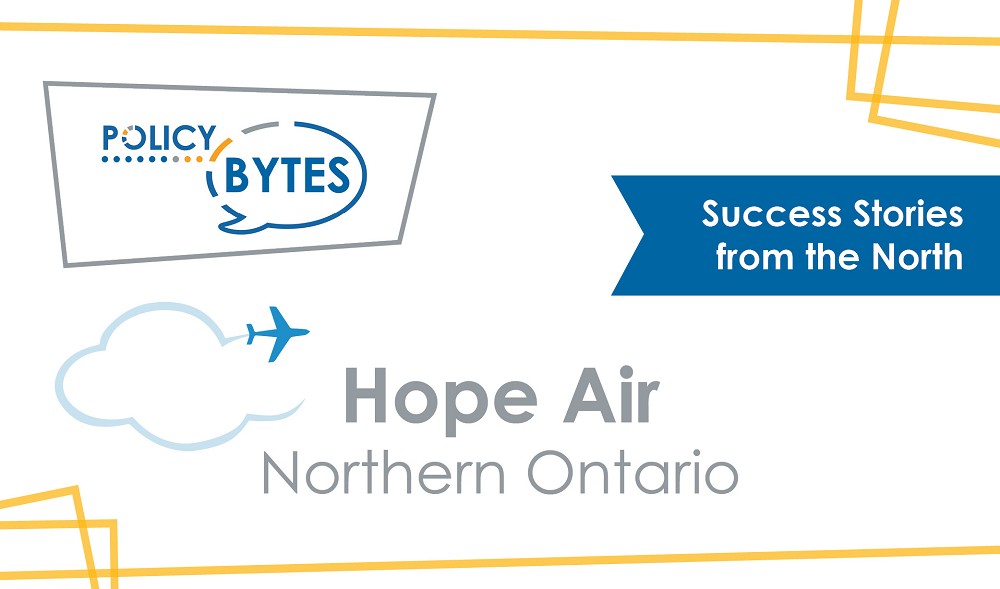How a Charity Connects Canadians to Essential Services: the Story of Hope Air
November 4, 2020 - In 1984, Jinnie Bradshaw was inspired after learning about the Corporate Angel Network in the United States, which transported cancer patients to their treatment using corporate planes.

Jinnie knew there was a need for a similar service in Canada. So, she decided to quit her job and follow her passion, creating a charity to help patients get to treatment. Soon after, Jinnie was introduced to Joan Rogers through mutual contacts. At the time, Joan was volunteering at Princess Margaret Cancer Centre in Toronto and had witnessed firsthand the struggle of long-distance travel on cancer patients. In 1986, the two women decided to join forces and became the co-founders of Mission Air Transportation Network – now Hope Air.
In its first year, Hope Air arranged 56 flights to help patients get to treatment. Over the years, Hope Air has set up over 150,000 travel arrangements (including flights) for Canadians needing to travel long distances to reach important medical care.
The charity is founded on the idea that all Canadians should have the same access to healthcare regardless of where they live and their financial means. Also, it is important for people who are suffering to be able to focus on their health and not have the added stress of worrying about how/if they can get to treatment.
Imagine what it must be like to deal with the news of a devastating diagnosis and having to also worry about how you will be able to afford travelling back and forth for treatment. Some patients must drive or take a bus across the province to reach treatment and some cannot manage to make it to all their appointments. This is something that is experienced by many people throughout the Northern Ontario communities who have to travel to urban centres like Toronto, Ottawa or London for treatment.
This was the case for Lorena who was diagnosed with stage three high-grade serious carcinoma ovarian cancer and was referred to the Princess Margaret Cancer Centre in Toronto. The news came as a shock to the mother of two boys. Her specialist wanted to start treatment immediately and would be administered every three weeks in Toronto, which is an 11-hour drive from her home in Hearst. Lorena would not make the drive back home after receiving chemotherapy treatment. Luckily, Lorena was introduced to Hope Air by a social worker. The charity flew her and her medical escort to her treatment. Lorena told Hope Air that without them she probably would have had to borrow money and skip some appointments.
Rob Trahan is another example of a patient that Hope Air was able to help reach their much-needed medical care. Rob was diagnosed with prostate cancer and had to travel regularly from Timmins to Toronto for treatment. Rob was sitting in the waiting room at Princess Margaret when he came across a Hope Air pamphlet. He had never heard of the charity and could not believe the service was available. Rob reached out to Hope Air and they arranged to fly him to Princess Margaret every Monday and back home to Timmins every Friday evening.
These are simply two stories among many others where Hope Air has succeeded in helping alleviate the additional burden of getting to and from treatment from far away - like from a community in Northern Ontario.
It is important to understand that people living in northern communities have very different experiences with healthcare than is typical for the rest of the province. There a lot of challenges associated with delivering care to people in northern regions of Ontario because it is a very large area with an extremely low population density. The biggest issue is access. People may need to travel long distances to access care which can pose a real challenge – especially for remote communities where there may not be a local physician or specialist.
With the help of volunteer pilots and fundraising, Hope Air is working to fill the accessibility gaps many northern and remote communities feel when attempting to access medical treatments and services. The charity gives those living in distant communities the hope and resources needed to continue with their treatments, no matter the distance.
Write for us
Lindsey Champaigne is a Policy Analyst at NPI.
The content of Northern Policy Institute’s blog is for general information and use. The views expressed in this blog are those of the author and do not necessarily reflect the opinions of Northern Policy Institute, its Board of Directors or its supporters. The authors take full responsibility for the accuracy and completeness of their respective blog posts. Northern Policy Institute will not be liable for any errors or omissions in this information, nor will Northern Policy Institute be liable for any detriment caused from the display or use of this information. Any links to other websites do not imply endorsement, nor is Northern Policy Institute responsible for the content of the linked websites.
Northern Policy Institute welcomes your feedback and comments. Please keep comments to under 500 words. Any submission that uses profane, derogatory, hateful, or threatening language will not be posted. Please keep your comments on topic and relevant to the subject matter presented in the blog. If you are presenting a rebuttal or counter-argument, please provide your evidence and sources. Northern Policy Institute reserves the right to deny any comments or feedback submitted to www.northernpolicy.ca that do not adhere to these guidelines.
